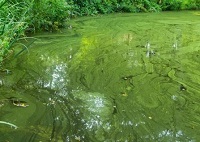
Emerging contaminants are naturally occurring or manmade chemicals present in drinking water that are known or suspected to pose risks to human health and are not yet subject to federal regulatory oversight. Some emerging contaminants of concern in Oregon include toxins produced by cyanobacteria (cyanotoxins), Per- and Polyfluoroalkyl Substances (PFAS), and Manganese.
The US Environmental Protection Agency (EPA) uses the Unregulated Contaminant Monitoring Rule (UCMR) to collect data for contaminants that are suspected to be present in drinking water and do not have health-based standards set under the Safe Drinking Water Act (SDWA).
On this page:
Cyanotoxins
Oregon Health Authority (OHA) has developed regulations that require drinking water systems using surface water sources susceptible to harmful algae blooms to routinely test for cyanotoxins that these blooms produce and notify the public about the test results.
Per- and Polyfluoroalkyl Substances (PFAS)
Oregon Health Authority (OHA) has established drinking water health advisory levels (HALs) for four PFAS compounds most commonly found in humans. These health advisory levels for PFOS, PFOA, PFNA, and PFHxS are set at levels meant to protect all persons, including sensitive populations, from both short and long-term exposures in drinking water.
Manganese
Manganese is a naturally occurring element found in soil, water, and air. It is commonly found in foods such as nuts, legumes, seeds, grains, and green leafy vegetables and in drinking water. Our bodies require small amounts of manganese to stay healthy. Too much manganese can increase the risk of health problems, particularly for infants under 6 months old. Infants are more at risk than older children and adults because their brains and bodies are quickly developing. Formula-fed infants get enough manganese from formula to meet their dietary needs. However, they may get too much manganese (above the recommended amount for nutrition) in their bodies when formula is mixed with water that contains manganese. Infants exposed to manganese over the EPA established health advisory level of 0.3 mg/L for 10 or more days may experience learning or behavioral problems. Adults who drink water with high levels of manganese for many years may experience impacts to their nervous system. EPA established a lifetime health advisory level of 0.3 mg/L which means adverse health effects are not expected below this level.
Drinking Water Source Protection and Emerging Contaminants
Pharmaceutical and Personal Care Products (PPCPs)
Pharmaceuticals and Personal Care Products as Pollutants (PPCPs) are a diverse collection of thousands of chemical substances comprising all products used by individuals for personal health or cosmetic reasons and those used by agribusiness to enhance growth or health of livestock. Some examples of PPCPs are prescription and over-the-counter drugs, veterinary drugs, dietary supplements, fragrances, cosmetics and lotions, and laundry and cleaning products. See the following for more information: